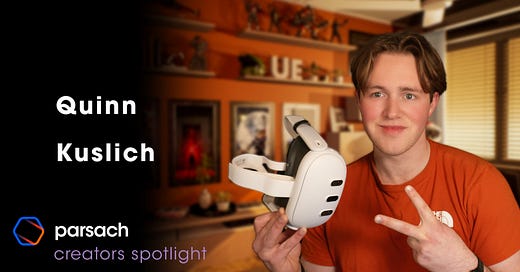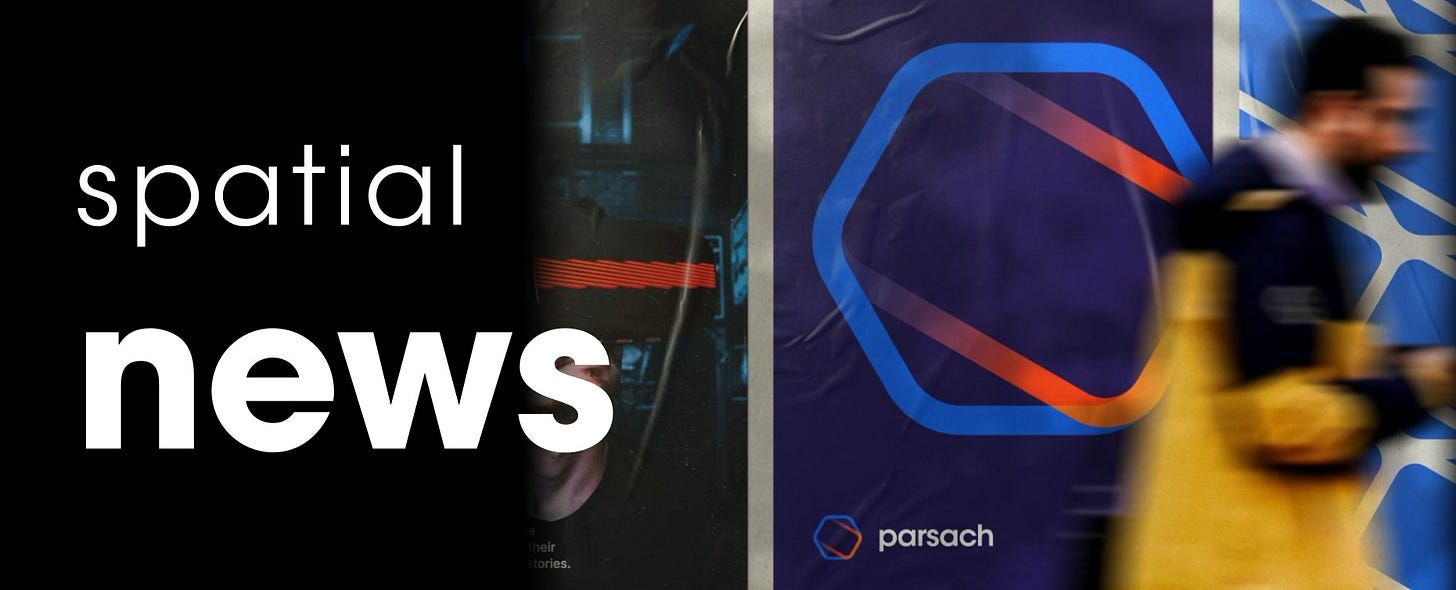Hello everyone.
As we wrap up 2024, it is hard to imagine that the Apple Vision Pro was only released a couple of months ago, and there were more headsets throughout the year. Not to mention the many other devices already announced for 2025 (looking at you, Android XR!).
Therefore, in this edition, we want to celebrate the best of 2024 and introduce our latest experience, Broken Rock, by our wonderful spotlight of the week, Quinn Kuslich.
Remember, if you want access to the parsach platform you need to request an invite on Discord, TikTok, Instagram, or YouTube because we’re currently invite-only.
Now, let’s get into the news 📰
CNET
In 2024, many outstanding AR and VR devices were released, including the Apple Vision Pro and Quest Vision 3s. Check out CNET's video review for further insights into the headset market and discover its strengths and weaknesses.
Pimax Dream Air
Looking ahead to 2025, the early release of the Pimax Dream Air is going to be something special. This advanced headset features eye, hand, and head tracking, as well as spatial audio and stunning micro-OLED visuals with a resolution of 3840 x 3552 pixels per eye at a refresh rate of 90 Hz.
Without a doubt, Pimax is leading the way in high-end headset technology.
It’s with great pride that we introduce to our community the incredible Quinn Kuslich and his latest experience Broken Rock.
Quinn’s a professional VR developer and Unreal Engine expert with over seven years of experience creating immersive experiences across industries like medicine, automotive, and gaming. Plus, he shares his expertise through YouTube tutorials, focusing on VR development, game design, and technical artistry.
Now, let’s meet Quinn.
Q: What inspired you to dive into VR content creation, and how do you see immersive storytelling evolving in the next few years as spatial computing continues to grow?
A: I’ve always been passionate about video games and immersive storytelling. VR captured my imagination because it allows you to create experiences where players are an active participant in the story. When I started working in VR, I saw the potential to blur the lines between the digital and physical worlds, and that’s been my driving motivation ever since. Looking ahead, I believe spatial computing will push immersive storytelling to new heights. With advancements in AI and machine learning I expect narratives to become more interactive, adaptive, and personal, giving users the ability to shape their own stories in ways we’ve never seen before.
Broken Rock - available now in the parsach platform
Q: For aspiring XR developers, what would you recommend as the most effective way to learn and build a portfolio that stands out in this competitive industry?
A: Start by making things - jump in and create your own XR projects, no matter how small or experimental. The best way to learn is through hands-on experience, and personal projects will show potential employers your creativity, technical skills, and problem-solving abilities. A great portfolio doesn’t just demonstrate what you can do - it tells a story about the kind of developer you are. Include diverse projects that highlight your range, from technical problem-solving to creative innovation.
I take a hands-on approach in my own work, constantly challenging myself with new projects to diversify my skill set and explore areas where I’m less experienced. Pushing yourself to grow outside of your comfort zone is one of the best ways to improve and stand out in this field. I always recommend leveraging resources like YouTube, Udemy, ArtStation Learning, and Gumroad. These platforms offer fantastic tutorials and guides to help you dive into XR development, whether you’re learning the basics or mastering advanced techniques. Finally, stay curious and enjoy the process. XR is about bringing ideas to life and pushing the boundaries of what’s possible. If you approach your work with excitement, that passion will shine through and make you stand out in this fast-growing industry.
Q: You’ve worked on both medical VR simulations and game development. How do you approach creating immersive experiences that balance technical accuracy with user engagement?
A: Professionally, I’m often approached with a simple but critical question: “Is this possible?” My job is to answer that question and turn it into reality, whether I’m working in medicine or automotive design. In both fields, technical accuracy is paramount. In my medical work, I’ve developed VR experiences to showcase innovative medical devices with precision, helping surgeons and doctors understand their capabilities. I’ve also designed cancer treatment experiences aimed at alleviating patient anxiety during experimental radiation therapy, carefully crafting these experiences to prepare users for their treatment sessions in a calm, supportive way. This combination of technical rigor and empathetic design ensures these projects meet their goals effectively.
For game development, the approach shifts toward creativity and engagement. Here, the focus is on crafting experiences that immerse players and evoke emotion, whether through dynamic mechanics or compelling environments. While accuracy isn’t always the top priority, the goal remains the same: creating something impactful and memorable for the end user.
Across all XR work - whether professional simulations or games - I maintain a user-first mindset. Understanding the customer, client, or player and their expectations is essential. I create products to solve problems, always with a focus on the intended experience. By tailoring each solution to its audience I ensure the results not only meet their goals but also deliver meaningful and immersive experiences every time.
Q: Your YouTube channel features detailed reviews of Unreal Engine plugins. What are the top three plugins you believe every developer should know about, and why?
A: Barney's Basement: I can’t recommend this enough for VR developers. It’s a demo project for Unreal Engine 5 that includes over 150 high-quality props, 15 materials, and a fully integrated Lumen/Nanite scene. It’s perfect for anyone exploring VR workflows, or needing a robust VR grab system ready to go. It’s been an invaluable resource for me when working on polished VR environments. (GitHub)
Head Mounted VR: This plugin is inspired by the mechanics of Half-Life: Alyx and brings so much to the table for immersive VR experiences. It features physically based interactions, making object manipulation and environmental interaction feel incredibly realistic. If you’re creating a VR project and want a seamless, high-quality interaction system, this is a must-have.(HeadMountedVR)
Unreal Engine Content Examples: This one is an absolute treasure trove of information and knowledge. It’s a free plugin from Epic Games, and I’ve used it countless times when I’ve been stuck on the basics or needed to explore more advanced techniques. The examples cover everything from lighting to animation to physics, and Epic is constantly updating it with the latest tech. It’s perfect for learning or troubleshooting Unreal Engine workflows. (Unreal Marketplace)
These plugins have been instrumental in my own development, and I believe they’re some of the best tools out there for creating high-quality and immersive Unreal Engine projects.
One last thing
2024 was phenomenal!
We have collaborated with amazing artists, creators, developers, and companies to build a vibrant community in a space we truly love. Thus, we want to take a moment to express our gratitude for all the incredible support we have received.
Thank you!
Until next year, and don’t forget to connect with us in Discord and keep up with the news on TikTok, Instagram, YouTube.
🫶






